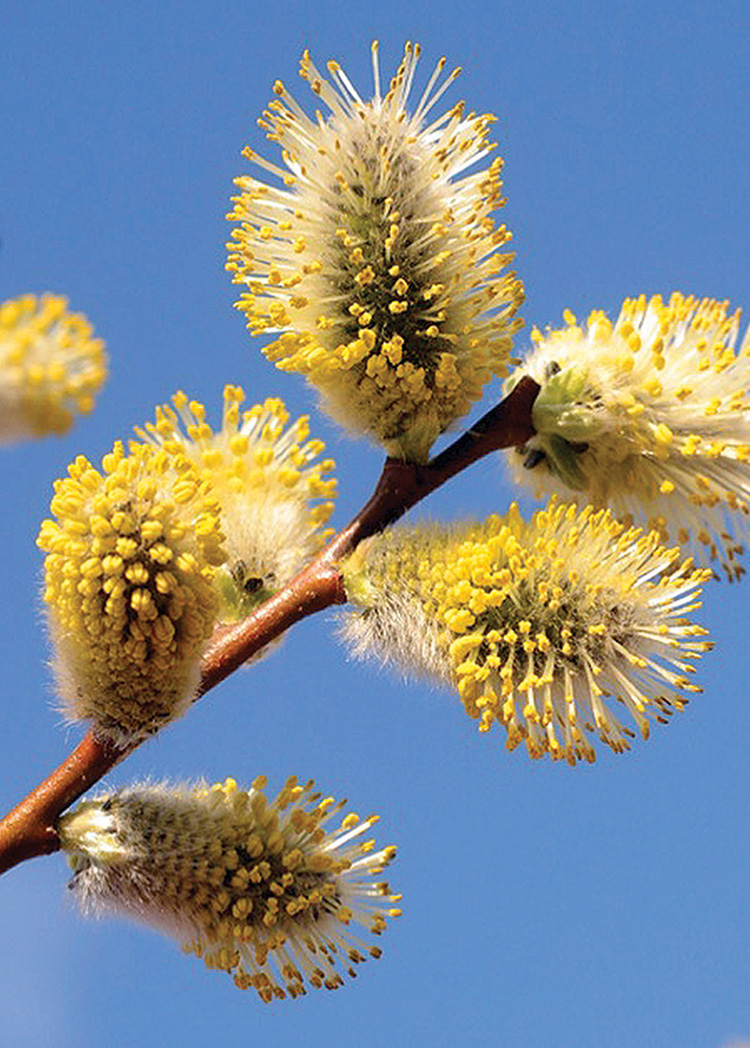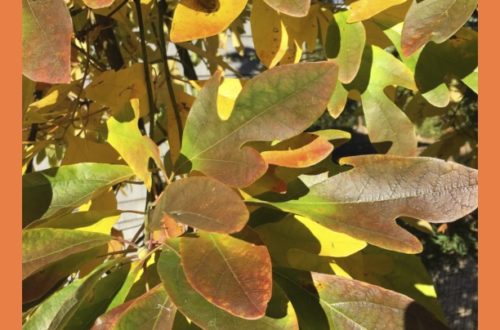By Dr. Julia Kuzovkina
SEPT-OCT 2017 – Belonging to the family Salicaceae, the genus Salix comprises about 450 species. It is distributed worldwide but occurs mostly in the Northern Hemisphere. Willows occur in several forms: large and small trees, shrubs, and groundcovers that are only a few centimeters tall. Their habits vary from upright, to pendulous, to spreading.
Willows are tolerant of a wide range of climates. Predominantly occurring in temperate and arctic zones, they’re also found in the subtropics and tropics.
Willows are the only woody species in some alpine zones known as zones of dwarf willows. They also play an important role in the vegetative cover of tundra and areas above tree lines.
The center of abundance of willows is in China, with almost 200 native species. There are 113 species inhabiting North America, including some 22 species native to New England.
New England species are mostly lowland species. See photos 1 and 2, and the chart at the end of the story.
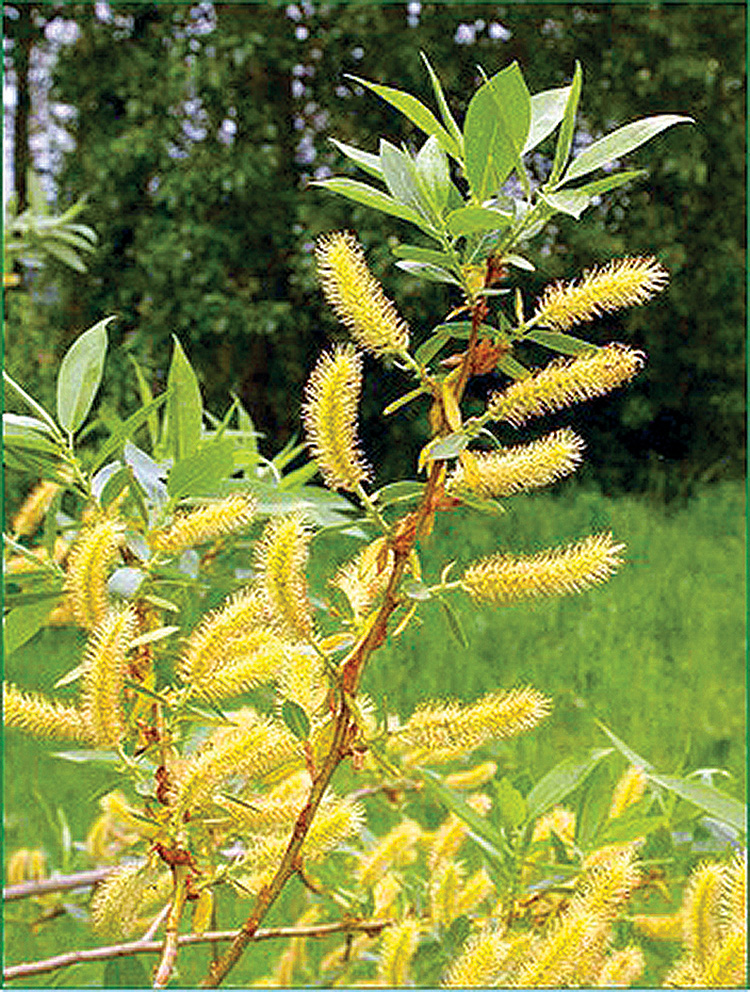
Most people know about pussy willows, which are collected in the spring for decorative arrangements, or weeping willows, which are widely planted as ornamentals throughout the region. However, there are 22 species native to New England. The attractive Salix lucida, shining willow, is among them.
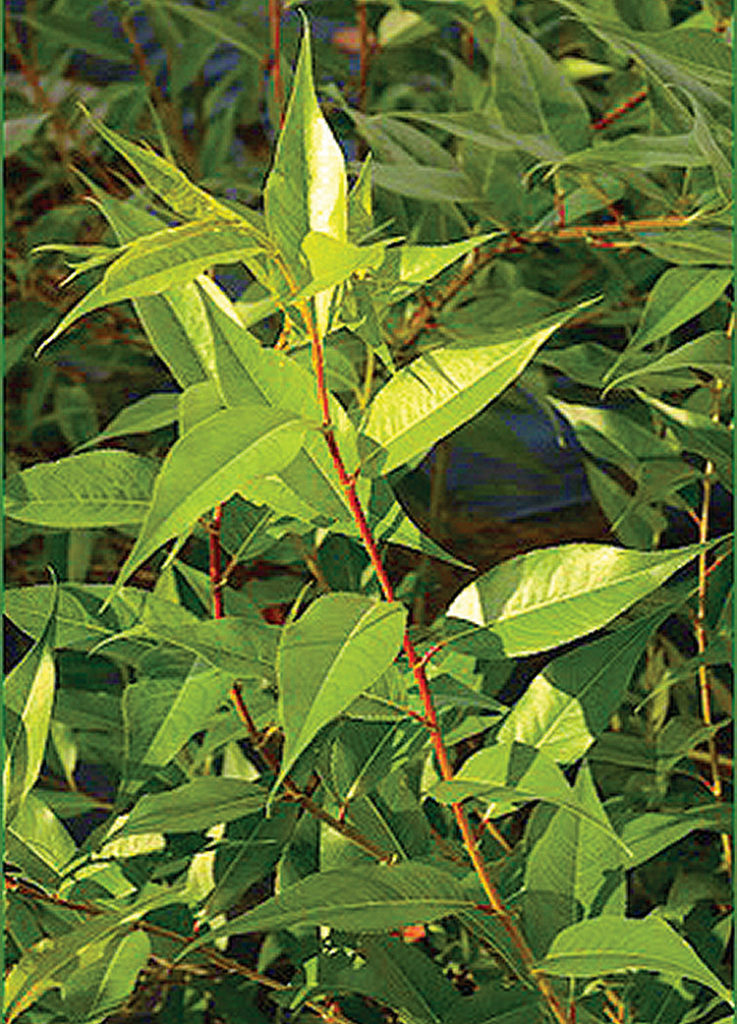
Five species – S. arctophila, S. argyrocarpa, S. herbacea, S. uva-ursi and S. planifoia – have narrow distributions in alpine ravines in northern New England.
In addition to the natives, a few introduced species are listed in New England floras, of which the most common include S. alba, S. atrocinerea, S. caprea, S. cinerea, S. x fragilis and S. x sepulcralis (weeping willow).
See chart at end of story.
Ecology
Species of Salix differ in their ecological requirements, although the majority of them are adapted to moderately moist (mezic) and wet (hydric) habitats.
Moisture availability is an important factor controlling native distribution and abundance of the species. Willow seed, which is seated in a ring of fine hairs that facilitate dispersal by wind, contains chlorophyll but no endosperm and has limited longevity.
In order to germinate, seed must be exposed to moist surfaces within a few days. Abundant moisture is important during seed germination and early seedling establishment. However, after that stage, constant soil moisture is not as important to the survival of many willows.
When established, some species can survive extreme water fluctuations and prolonged periods of partial inundation. Their ability to withstand root exposure and heavy sediment deposition, or burial, as a result of water and wind erosion, relies on adventitious rooting of buried stems and the flush or break of dormant buds.
These adaptations allow willows to survive in the constantly changing environments of flood plains, water margins and sandbars.
Riparian or alluvial species (for example, S. nigra and S. alba) growing along river valleys, stream banks and lakeshores, require well-aerated substrate and flowing moisture. Non-riparian species, such as S. discolor and S. petiolaris, are less exacting in soil aeration requirements and include wetland species that are well adapted to saturated soils. See photo 3.

Stands of Salix nigra and S. amygdaloides along Lake Champlain in Vermont.
Some willow species are even adapted to drought and heat stress and exhibit xeric traits. For example, S. humilis, S. tristis and S. cordata inhabit sandy roadsides, plains and sand dunes. See photo 4.

Salix cordata on sand dunes along Lake Ontario in New York.
The ecology of willows also includes the strategy of early successional plants colonizing newly opened habitats. These comprise manmade habitats such as abandoned agricultural fields, railroads, old mine tailings and gravel pits. They also include recently burned, glaciated (soilless) or flooded areas where disturbance results in an open community with low competition levels, allowing a temporary increase in the dominance of opportunistic species.
Identification
Salix is a difficult genus to identify at the species level due to considerable individual variability, interspecies hybridization other factors.
In addition, in precocious species, the flowers appear before the leaves. This non-concurrent phenology of flowers and leaves make the simultaneous observation of important morphological characteristics nearly impossible.
It is useful to know a set of characters representing distinctive morphological features for each species to be certain that identification is positive.
For example, S. interior from the subgenus Longifoliae, which comprises only a few New World species, has long linear leaves with stomata on both sides, a leaf margin with remote dentation (the teeth are far apart) and branched catkins. S. interior propagates by root suckers, forming dense thickets. In nature, clonal propagation is unusual in Salix and only species from Longifoliae form root suckers. See photos 5 and 6.
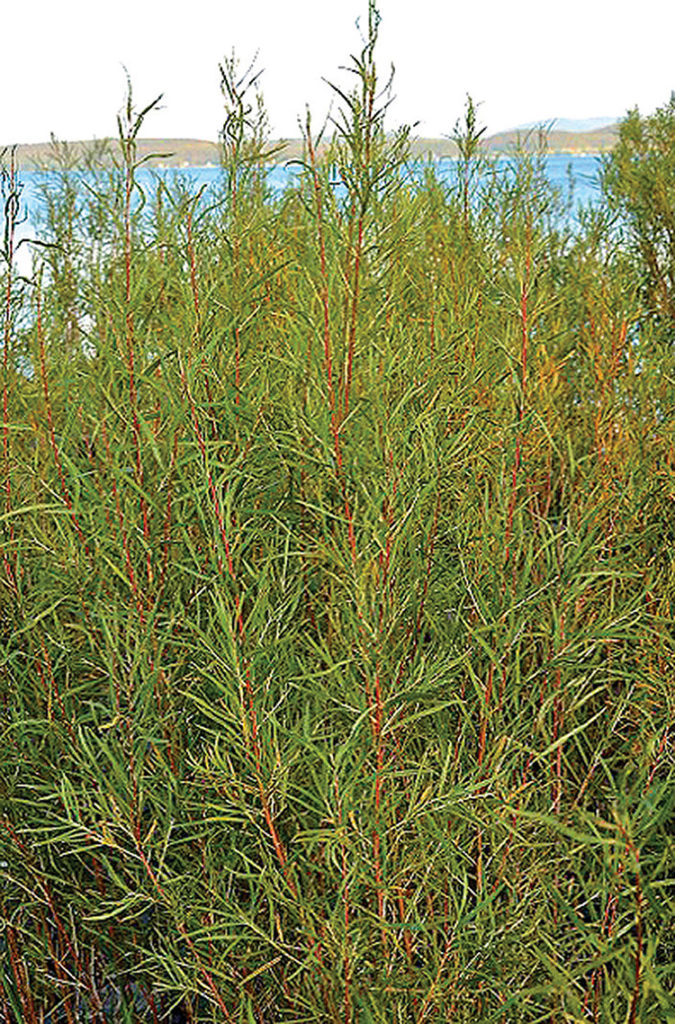
Salix interior with long narrow leaves.
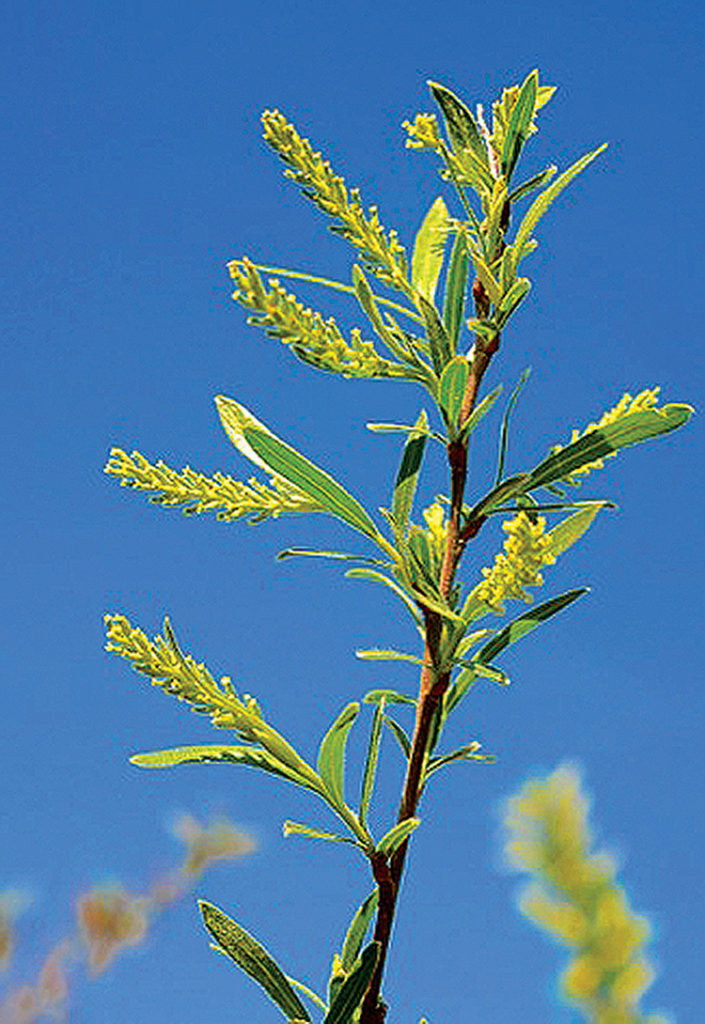
Salix interior with female catkins borne on distinct flowering branchlets.
In winter time, buds can assist in identification of some species. Two kinds of buds are found on willow stems: generative flower buds and vegetative leaf buds.
In Salix discolor, which flowers early in the spring, very distinct large flower buds occur mostly on the upper portion of the branch, with smaller leaf buds occurring below the inflorescences. In S. nigra and S. amygdaloides, leaf and flower buds are uniform in size and shape and are not distinguishable. See photo 7.

The sequence of flowering and the development of shoots vary among species, and few patterns of annual development are recognized.
Precocious species, such as Salix sericea and Salix discolor, flower before leaves emerge. Species with this habit typically have sessile catkins (flowers). The flowers are borne directly on the stem, there is no pedicel or stalk. See photos 8 and 9.
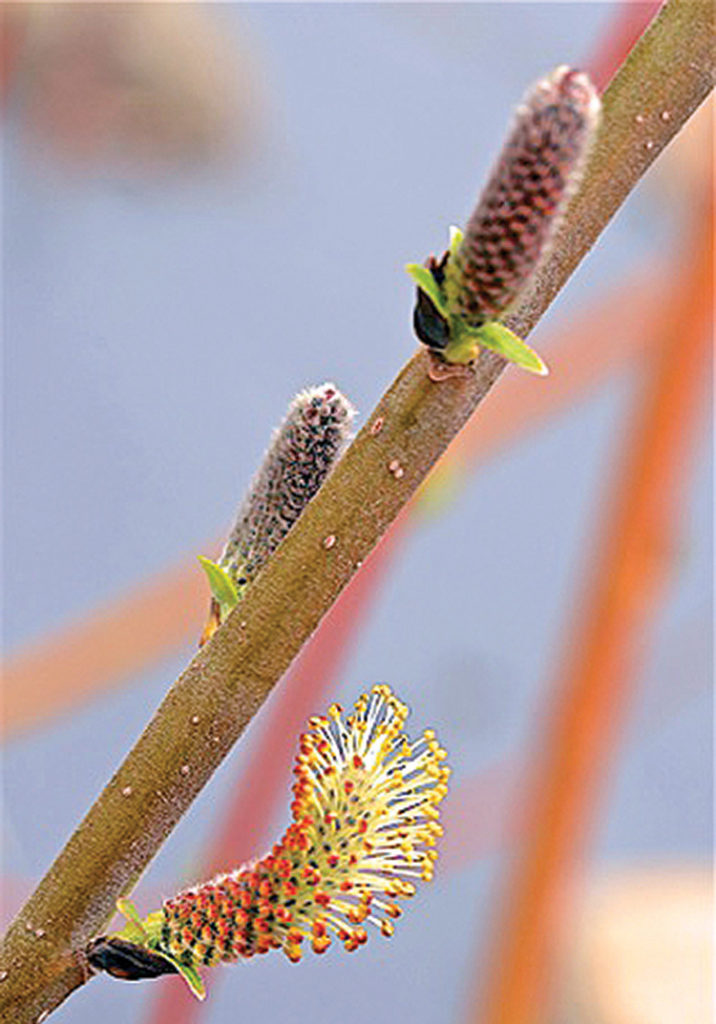
Salix discolor – a New England native species that is precocious
(the flowers emerge before leaf break).
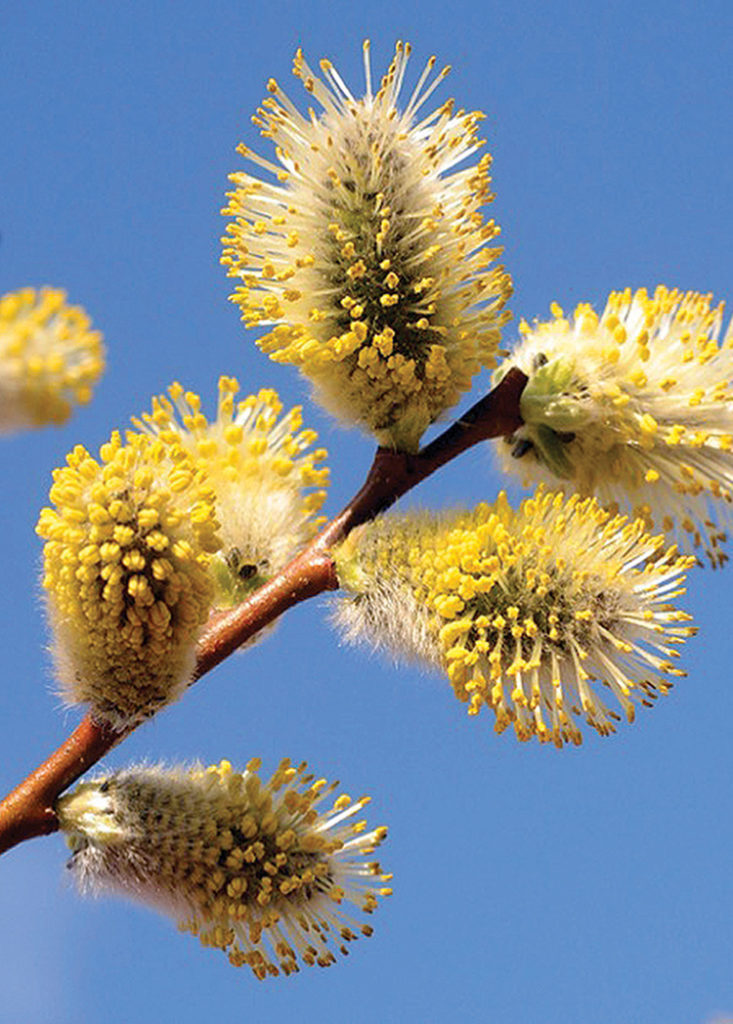
Salix discolor – another New England native species that’s precocious
(the flowers emerge before leaf break).
In subprecocious species, Salix bebbiana for example, generative budburst and flowering occur just before the emergence of leaves. Catkins of species with this habit are sessile and borne on short, flowering branchlets.
In coetaneous species, flowering and leaf emergence take place simultaneously. In Salix lucida, Salix nigra and Salix serissima, the flowers are borne on distinct flowering branchlets.
All willow species are dioecious with male and female catkins occurring on separate plants. Single-sex flowers are arranged into mostly upright catkins. Salix flowers are predominantly insect pollinated, but wind pollination takes place as well. See photo 10.
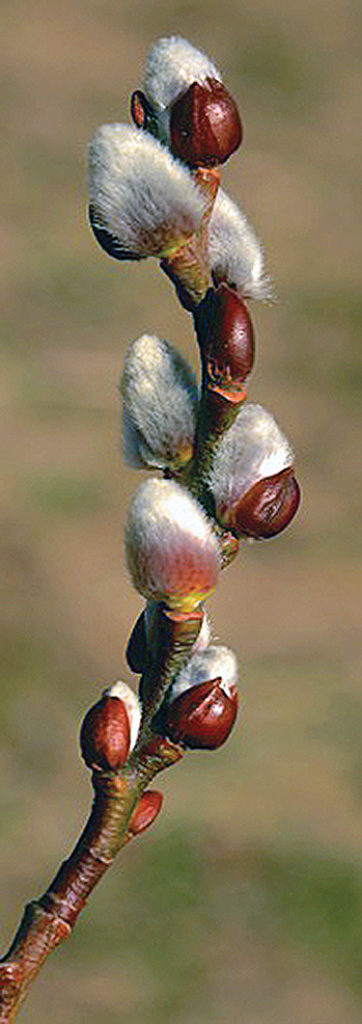
Generative buds contain embryonic flowers with rudimentary leaves that form during the preceding year and continue development throughout the winter, resulting in gradual ex-pansion of the inflorescence until it pushes off the bud scale. Each flower in the inflorescence is subtended by a floral bract with dense hairs – these bracts create the pussy willow effect in some species.
Each willow flower has a variable number of nectariferous glands or nectaries. Because flowering takes place in early spring, willows are very important for pollinators, providing both nectar and pollen.
The roots of a some tree-type willows (such as weeping willow and white willow) can damage underground structures and should not be planted near houses.
Shrub-type species have an extensive fibrous root system with the majority of fine roots found in the upper 40-45 centimeters of the soil profile. Most willows form root primordia on stem nodes and root easily.
A few species form root suckers (S. interior), create small colonies by layering (S. humilis), or propagate vegetatively by broken branches that are brittle at the base (S. nigra).
Utilization
The uses of willows are as diverse as the biodiversity of the genus. Indeed, willows have a long history with humans.
Indigenous peoples in North America and Eurasia used willow bark infusions as analgesics and for at least two centuries before the synthetic production of aspirin, salicin extracted from Salix bark, was commercially exploited.
Flexible willow stems were also the primary material for basket production and straight willow branches were used for arrow shafts, fish traps and numerous other items.
More recently, willow was proposed as a biomass crop for bioenergy and bioproducts, representing promising feedstock crop in many countries.
Its plantations can be productive for 25 years due to plants’ ability to resprout from stumps after repeated harvesting – so called coppicing.
The primary focus on willow production has expanded over the past decade to include various conservation and environmental goals.
Today, willow is cultivated not only to produce biomass for energy, but also to filter various waste products through contaminant uptake from the soil and water, and is adapted for many environmental applications, such as phytoremediation, riparian buffers and shelterbelts.
They are also widely used for reclamation of disturbed sites where Salix species anchor a pioneer community, accelerating the recovery of damaged ecosystems and the re-establishment of natural ecological omplexity. See photos 11 and 12.


Julia Kuzovkina is an associate professor at UConn. She received her doctoral degree in horticulture from Ohio State and a master’s in botany from Moscow State University. Dr. Kuzovkina’s research has focused on environmental horticulture, phytoremediation and selection of plants for environmental applications.
Willows & Some of their Common Names
New England Species
• S. amygdaloides – peachleaf willow
• S. bebbiana – Bebb’s willow
• S. candida – sageleaf willow
• S. cordata – sand dune willow
• S. discolor – American pussy willow
• S. eriocephala – Missouri River willow
• S. exigua – sandbar willow*
• S. humilis – prairie willow
• S. interior – sandbank willow
• S. lucida – shiny willow
• S. myricoides – bayberry willow
• S. nigra – black willow
• S. occidentalis – dwarf prairie willow
• S. pedicellaris – bog willow*
• S. pellita – satin willow
• S. petiolaris – meadow/slender willow†
• S. pyrifolia – balsam willow
• S. rigida – heartleaf willow
• S. sericea – silky willow
• S. serissima – autumn willow
Narrow Distribution Alpine Ravines
• S. arctophila – northern willow
• S. argyrocarpa – Labrador willow
• S. herbacea – snow-bed willow
• S. planifolia – tea-leaved willow
• S. uva-ursi – bearberry willow
Introduced Species
• S. alba – white willow
• S. atrocinerea – rusty willow
• S. caprea – goat willow
• S. cinerea – gray willow
• S. x fragilis – crack/brittle willow
• S. x sepulcralis – golden weeping willow
* Endangered species in Connecticut
† Species of special concern
Sources
• gobotany.newenglandwild.org
• plants.usda.gov
